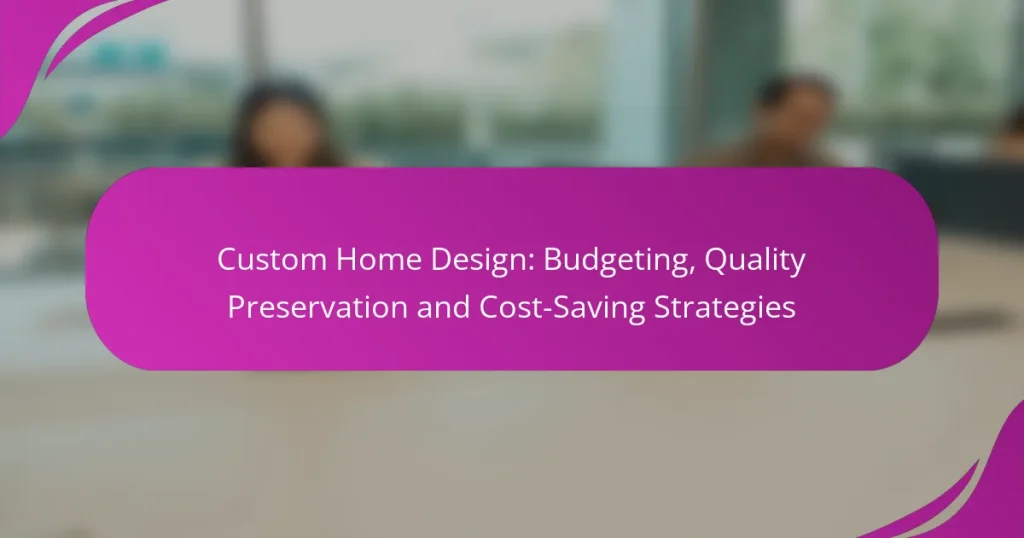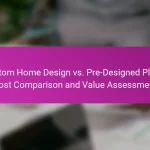Custom home design requires careful budgeting to balance financial constraints with quality preservation. By establishing clear financial parameters and selecting skilled professionals, homeowners can ensure their projects remain within budget while achieving a durable and aesthetically pleasing result. Additionally, incorporating cost-saving strategies such as energy-efficient designs and modular construction can further enhance value without compromising quality.

What are the budgeting strategies for custom home design in Canada?
Effective budgeting strategies for custom home design in Canada focus on establishing clear financial parameters and understanding various contract types. By selecting the right approach, homeowners can manage costs while ensuring quality in their projects.
Fixed-price contracts
Fixed-price contracts involve a set total price for the entire project, which provides clarity and predictability in budgeting. This approach is beneficial for homeowners who prefer to know their maximum expenditure upfront, reducing the risk of unexpected costs.
However, it is essential to ensure that the contract details are comprehensive, covering all aspects of the design and construction. Any changes or additional requests may lead to extra charges, so clear communication with the contractor is crucial.
Cost-plus contracts
Cost-plus contracts allow homeowners to pay for the actual costs of construction plus a predetermined fee or percentage for the contractor’s profit. This method can be advantageous when project requirements are not fully defined at the outset, providing flexibility for adjustments.
While this approach can lead to higher overall costs if not monitored closely, it encourages collaboration between the homeowner and contractor. Regular updates on expenses can help keep the project within budget and maintain transparency.
Budget contingencies
Including budget contingencies in your planning is vital for managing unexpected expenses during the custom home design process. A common recommendation is to set aside around 10-20% of the total budget as a contingency fund.
This reserve can cover unforeseen issues such as design changes, material price increases, or delays. Homeowners should regularly review their spending against the budget and adjust their contingency as needed to ensure financial stability throughout the project.

How can I preserve quality in custom home design?
To preserve quality in custom home design, focus on selecting skilled professionals, sourcing premium materials, and implementing thorough quality control measures throughout the project. These steps ensure that your investment results in a durable and aesthetically pleasing home.
Use reputable contractors
Choosing reputable contractors is crucial for maintaining quality in custom home design. Look for professionals with strong references, positive reviews, and a proven track record in similar projects. Verify their licenses and insurance to ensure they meet local regulations.
Consider interviewing multiple contractors to compare their approaches and pricing. A well-established contractor may charge more, but their experience can save you money in the long run by avoiding costly mistakes.
Source high-quality materials
High-quality materials are essential for the longevity and appearance of your custom home. Research suppliers who offer durable, sustainable options that fit your design vision. Materials like solid wood, high-grade insulation, and energy-efficient windows can significantly impact both aesthetics and energy costs.
When budgeting, allocate a portion of your funds specifically for premium materials. While these may have a higher upfront cost, they often lead to lower maintenance and replacement expenses over time.
Implement quality control measures
Quality control measures help ensure that your custom home meets your expectations and industry standards. Establish a clear timeline and checklist for inspections at various stages of construction. This allows you to address any issues promptly before they escalate.
Consider hiring a third-party inspector to provide an unbiased assessment of the work completed. Regular site visits and open communication with your contractor can also help maintain quality throughout the building process.

What cost-saving strategies can I apply to custom home design?
Implementing cost-saving strategies in custom home design can significantly reduce expenses while maintaining quality. Key approaches include energy-efficient designs, modular construction, and exploring DIY options.
Energy-efficient designs
Energy-efficient designs focus on reducing energy consumption, which can lead to lower utility bills over time. Incorporating features such as high-quality insulation, energy-efficient windows, and solar panels can enhance your home’s sustainability.
Consider using Energy Star-rated appliances and fixtures, which can save you money in the long run. Additionally, optimizing natural light through strategic window placement can minimize the need for artificial lighting.
Modular construction
Modular construction involves prefabricating sections of your home off-site, which can lead to significant savings in labor and materials. This method allows for quicker assembly on-site, reducing construction time and associated costs.
When considering modular options, ensure that the designs meet local building codes and regulations. This approach can also provide flexibility in design while maintaining quality, as many modular homes are built to high standards.
DIY options
Exploring DIY options can greatly reduce labor costs in your custom home design. Tasks such as painting, landscaping, or even installing fixtures can be manageable for homeowners willing to invest time and effort.
Before starting any DIY project, assess your skills and the complexity of the task. It may be beneficial to hire professionals for more intricate work, such as plumbing or electrical installations, to avoid costly mistakes.

What are the key factors affecting custom home design costs in Canada?
The key factors affecting custom home design costs in Canada include location, design complexity, and material choices. Understanding these elements helps homeowners budget effectively and make informed decisions throughout the building process.
Location and land costs
Location significantly influences custom home design costs, as land prices vary widely across Canada. Urban areas like Toronto and Vancouver typically have higher land costs compared to rural regions, which can affect the overall budget.
Additionally, site preparation expenses, such as grading and utilities, can add to costs. It’s essential to consider zoning regulations and potential development fees in your chosen area, as these can further impact your budget.
Design complexity
The complexity of the design directly affects the cost of custom home construction. More intricate designs, such as those with unique architectural features or multiple levels, generally require more labor and time, leading to higher expenses.
When planning your design, consider how simplicity can reduce costs. Opting for a straightforward layout with fewer custom features can help keep your budget in check while still achieving a beautiful home.
Material choices
Choosing materials is a critical factor in determining custom home design costs. High-quality materials, while often more expensive upfront, can lead to long-term savings through durability and lower maintenance costs.
It’s beneficial to compare different material options and their associated costs. For example, selecting standard-grade finishes instead of luxury materials can significantly reduce expenses without compromising the overall aesthetic of your home.

How do I choose the right architect for my custom home?
Choosing the right architect for your custom home involves evaluating their qualifications, experience, and communication style. A good architect will not only understand your vision but also help you navigate the complexities of design and construction within your budget.
Check credentials and experience
Start by verifying the architect’s credentials, including their education, licensing, and any professional affiliations. In the United States, architects must be licensed in the state where they practice, which typically requires passing the Architect Registration Examination.
Experience is equally important; look for architects who have worked on projects similar to yours. For instance, if you are building a sustainable home, find an architect with a background in eco-friendly designs.
Review past projects
Examine the architect’s portfolio to assess their design style and quality of work. Look for completed projects that resonate with your aesthetic preferences and functional needs. Pay attention to the scale and complexity of their past projects to ensure they can handle your custom home.
Consider reaching out to previous clients for feedback on their experiences. Ask about the architect’s ability to meet deadlines, stay within budget, and communicate effectively throughout the project.
Assess communication style
Effective communication is crucial for a successful partnership with your architect. During initial meetings, observe how well they listen to your ideas and respond to your questions. A good architect should be able to articulate their design concepts clearly and provide constructive feedback.
Establish whether their communication style aligns with your preferences. If you prefer frequent updates, ensure the architect is willing to provide regular progress reports and be available for discussions throughout the project.

What are the benefits of hiring a project manager for custom home design?
Hiring a project manager for custom home design offers numerous advantages, including improved communication, effective budget management, and adherence to timelines. These benefits can significantly enhance the overall quality and efficiency of your home-building experience.
Streamlined communication
A project manager acts as the central point of contact among all parties involved in the custom home design process, including architects, contractors, and suppliers. This role ensures that everyone is on the same page, reducing misunderstandings and miscommunications.
With a project manager, updates and changes are communicated promptly, which helps maintain clarity and focus throughout the project. This can save time and prevent costly errors that arise from miscommunication.
Budget management
Effective budget management is crucial in custom home design, and a project manager plays a key role in keeping expenses within limits. They help establish a realistic budget based on your needs and preferences, while also accounting for potential contingencies.
By monitoring costs throughout the project, a project manager can identify areas where savings can be made without compromising quality. This proactive approach can help avoid budget overruns, which are common in home construction.
Timeline adherence
Timely completion of a custom home is essential, and a project manager ensures that the project stays on schedule. They develop a detailed timeline and coordinate the various tasks involved in the construction process, making adjustments as necessary to address any delays.
By keeping all parties accountable and focused on deadlines, a project manager can help prevent the common pitfalls that lead to extended timelines. This efficiency not only saves time but can also reduce costs associated with prolonged construction.


